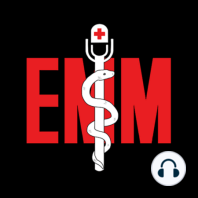2 min listen
Podcast 885: Penetrating Neck Injuries
ratings:
Length:
5 minutes
Released:
Jan 8, 2024
Format:
Podcast episode
Description
Contributor: Ricky Dhaliwal MD Educational Pearls: Three zones of the neck with different structures and risks for injuries: Zone 1 is the most caudal region from the clavicle to the cricoid cartilage Zone 2 is from the cricoid cartilage to the angle of the mandible Zone 3 is superior to the angle of the mandible Zone 1 contains the thoracic outlet vasculature (subclavian arteries and veins, internal jugular veins), carotid arteries, vertebral artery, apices of the lungs, trachea, esophagus, spinal cord, thoracic duct, thyroid gland, jugular veins, and the vagus nerve. Zone 2 contains the common carotid arteries, internal and external branches of carotid arteries, vertebral arteries, jugular veins, trachea, esophagus, larynx, pharynx, spinal cord, and vagus and recurrent laryngeal nerves Lower risk than Zone 1 or Zone 3 Zone 3 contains the distal carotid arteries, vertebral arteries, jugular veins, pharynx, spinal cord, cranial nerves IX, X, XI, XII, the sympathetic chain, and the salivary and parotid glands Hard signs that indicate direct transfer to OR: Airway compromise Active, brisk bleeding Pulsatile hematomas Hematemesis Massive subcutaneous emphysema Soft signs that may obtain imaging to determine further interventions: Hemoptysis Oropharyngeal bleeding Dysphagia Dysphonia Expanding hematomas Soft sign management includes ABCs, type & screen, and airway interventions followed by imaging of the head & neck area Patients with dysphonia or dysphagia with subsequent negative CTAs may get further work-up via swallow studies References Asensio JA, Chahwan S, Forno W, et al. Penetrating esophageal injuries: multicenter study of the American Association for the Surgery of Trauma. J Trauma. 2001;50(2):289-296. doi:10.1097/00005373-200102000-00015 Azuaje RE, Jacobson LE, Glover J, et al. Reliability of physical examination as a predictor of vascular injury after penetrating neck trauma. Am Surg. 2003;69(9):804-807. Ibraheem K, Wong S, Smith A, et al. Computed tomography angiography in the "no-zone" approach era for penetrating neck trauma: A systematic review. J Trauma Acute Care Surg. 2020;89(6):1233-1238. doi:10.1097/TA.0000000000002919 Nowicki JL, Stew B, Ooi E. Penetrating neck injuries: A guide to evaluation and managementx. Ann R Coll Surg Engl. 2018;100(1):6-11. doi:10.1308/rcsann.2017.0191 Summarized by Jorge Chalit, OMSII | Edited by Meg Joyce & Jorge Chalit, OMSII
Released:
Jan 8, 2024
Format:
Podcast episode
Titles in the series (100)
REBOA: Introduction of the use of REBOA for hemorrhagic shock. by Emergency Medical Minute
